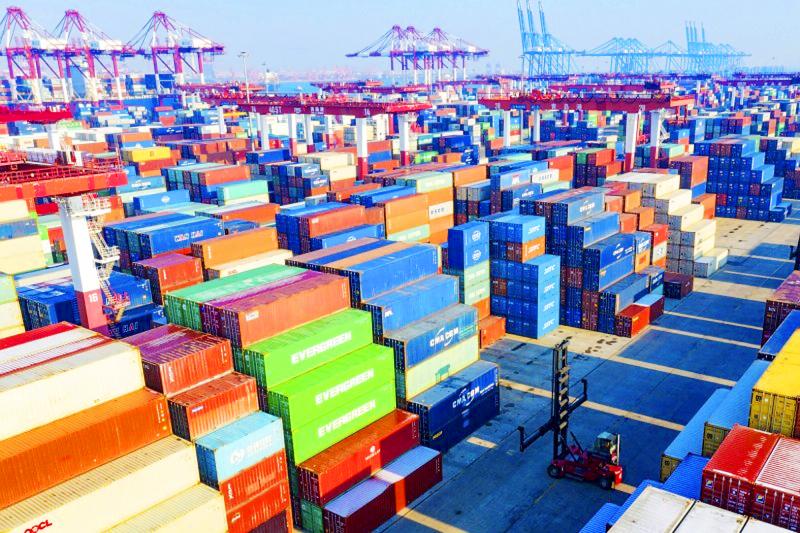Taiwan’s exports last month clocked another 12 percent upturn from a year earlier to a record US$33 billion, as 5G smartphones and other new technology applications ramped up business for local component suppliers, the Ministry of Finance (MOF) said yesterday.
The growth momentum might gather further strength this month with increases from 19 percent to 23 percent, aided by three more working days in January this year compared with last year, the ministry said.
“The factors driving the growth look sustainable and the timing of the Lunar New Year holiday will also lend support,” Department of Statistics Director-General Beatrice Tsai (蔡美娜) told a news conference in Taipei.

Photo: Wu Chi-lun, Taipei Times
Demand for 5G communication, high-performance chips, as well as remote-working and education devices remain high, Tsai said, adding that iPhone 12 sales proved stronger than expected.
Taiwan is home to suppliers of chips, camera lenses, casing, touch panels, battery packs and assemblers to Apple Inc.
Meanwhile, strong demand for laptops, servers, and other information and communication technology (ICT) products showed no sign of receding as COVID-19 infections spike around the world, Tsai said.
Electronics exports soared 22.2 percent to US$12.76 billion, while shipments of ICT products gained 17.6 percent to US$4.77 billion, jointly contributing about 50 percent to overall exports, ministry data showed.
Optical products, mainly flat panels, posted the fastest advance of 27 percent year-on-year, Tsai said.
Demand for non-technology products also showed a healthy recovery — with shipments of plastic, chemical and base metal products gaining 2 percent to 15.5 percent, the ministry said, adding that mineral and textile products continued to buck the trend, slumping up to 52.4 percent year-on-year.
Import data showed a positive cyclical movement for the second straight month, even though the increase tapered to 0.9 percent, giving Taiwan a large trade surplus of US$5.76 billion that has more than doubled year-on-year, Tsai said.
Imports of capital equipment dropped 6.4 percent due to the timing of equipment arrivals, she said.
Exports rose 11.7 percent year-on-year to US$97.21 billion last quarter, stronger than the November forecast of 7.8 percent by the Directorate-General of Budget, Accounting and Statistics, Tsai said.
For the whole of last year, outbound shipments hit a record high of US$345.28 billion, representing a 4.9 percent increase from a year earlier, outperforming rivals around the world, Tsai said.
Imports grew a mild 3.2 percent to US$78.72 billion last quarter, allowing for a slim gain for the whole year of 0.3 percent to US$286.49 billion, she said.

CHIP RACE: Three years of overbroad export controls drove foreign competitors to pursue their own AI chips, and ‘cost US taxpayers billions of dollars,’ Nvidia said China has figured out the US strategy for allowing it to buy Nvidia Corp’s H200s and is rejecting the artificial intelligence (AI) chip in favor of domestically developed semiconductors, White House AI adviser David Sacks said, citing news reports. US President Donald Trump on Monday said that he would allow shipments of Nvidia’s H200 chips to China, part of an administration effort backed by Sacks to challenge Chinese tech champions such as Huawei Technologies Co (華為) by bringing US competition to their home market. On Friday, Sacks signaled that he was uncertain about whether that approach would work. “They’re rejecting our chips,” Sacks

Taiwan’s exports soared 56 percent year-on-year to an all-time high of US$64.05 billion last month, propelled by surging global demand for artificial intelligence (AI), high-performance computing and cloud service infrastructure, the Ministry of Finance said yesterday. Department of Statistics Director-General Beatrice Tsai (蔡美娜) called the figure an unexpected upside surprise, citing a wave of technology orders from overseas customers alongside the usual year-end shopping season for technology products. Growth is likely to remain strong this month, she said, projecting a 40 percent to 45 percent expansion on an annual basis. The outperformance could prompt the Directorate-General of Budget, Accounting and

NATIONAL SECURITY: Intel’s testing of ACM tools despite US government control ‘highlights egregious gaps in US technology protection policies,’ a former official said Chipmaker Intel Corp has tested chipmaking tools this year from a toolmaker with deep roots in China and two overseas units that were targeted by US sanctions, according to two sources with direct knowledge of the matter. Intel, which fended off calls for its CEO’s resignation from US President Donald Trump in August over his alleged ties to China, got the tools from ACM Research Inc, a Fremont, California-based producer of chipmaking equipment. Two of ACM’s units, based in Shanghai and South Korea, were among a number of firms barred last year from receiving US technology over claims they have

BARRIERS: Gudeng’s chairman said it was unlikely that the US could replicate Taiwan’s science parks in Arizona, given its strict immigration policies and cultural differences Gudeng Precision Industrial Co (家登), which supplies wafer pods to the world’s major semiconductor firms, yesterday said it is in no rush to set up production in the US due to high costs. The company supplies its customers through a warehouse in Arizona jointly operated by TSS Holdings Ltd (德鑫控股), a joint holding of Gudeng and 17 Taiwanese firms in the semiconductor supply chain, including specialty plastic compounds producer Nytex Composites Co (耐特) and automated material handling system supplier Symtek Automation Asia Co (迅得). While the company has long been exploring the feasibility of setting up production in the US to address